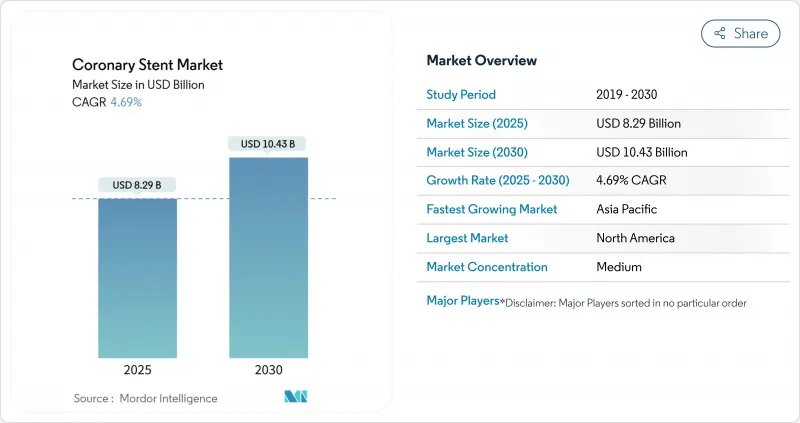
|
市場調査レポート
商品コード
1850944
冠動脈ステント:市場シェア分析、産業動向、統計、成長予測(2025年~2030年)Coronary Stent - Market Share Analysis, Industry Trends & Statistics, Growth Forecasts (2025 - 2030) |
||||||
カスタマイズ可能
適宜更新あり
|
|||||||
| 冠動脈ステント:市場シェア分析、産業動向、統計、成長予測(2025年~2030年) |
|
出版日: 2025年06月21日
発行: Mordor Intelligence
ページ情報: 英文 120 Pages
納期: 2~3営業日
|
概要
冠動脈ステント市場は、2025年に82億9,000万米ドルと評価され、2030年には104億3,000万米ドルに達し、予測期間中に4.69%のCAGRで進展すると予測されています。

健全な拡大は、着実な手技量、価値に基づく医療へのシフト、精度を向上させ合併症を減少させるAIガイド付き画像診断の急速な統合によって支えられています。病院は、二重抗血小板療法を短縮する超薄型ストラットを備えた薬剤溶出性プラットフォームを引き続き支持しており、アジアにおける公的調達改革が世界的な価格ダイナミクスを変化させています。コバルトクロム合金のサプライチェーン上の制約がハイエンドの生産に上限を与えているが、材料の革新がそのギャップを縮めています。多角的な医療技術企業間の統合は、血管内結石破砕術のような隣接技術が中核のステント・ポートフォリオを補強する、この分野の成熟化を示唆しています。
世界の冠動脈ステント市場の動向と洞察
CADの有病率の上昇と人口の高齢化
人口の高齢化とメタボリックシンドロームの蔓延に伴い、心血管疾患の罹患率は上昇を続けており、冠動脈ステント市場におけるインターベンションの需要を着実に押し上げています。糖尿病はPCI症例のおよそ4分の1に見られるようになり、高血糖患者専用のステントデザインは再狭窄をより低くしています。平均寿命が延びるということは、かつては保存的に管理されていた多枝病変がより多く出現することを意味します。支払者は、ステント留置は再入院に代わるコスト削減策であると考え、政策的支援を促しています。新興国は、都市部のライフスタイルが疾患の発症時期を短縮するため、この変化をより早く感じています。これらすべての要因が相まって、2030年まで対象となる患者のパイプラインは磐石なものとなるであろう。
急性冠症候群ガイドラインにおける早期PCIへのシフト
ガイドライン委員会は即時血行再建術を支持する傾向を強めており、PREVENTでは予防的PCIが内科的治療と併用された場合の標的血管不全率は0.4%であることが示されています。この姿勢はISCHEMIAから得られた微妙なエビデンスと共存しているため、臨床医は死亡率とQOLのバランスをとるためにリスク層別化アルゴリズムに依存しています。緊急の症例は一般に複雑であり、送達性の改善された高級なデバイスが好まれます。安定した疾患は頭打ちになるかもしれないが、急性の介入は増加し、予測可能な製品ミックスを生み出します。メーカーは、緊急の需要に迅速に対応できるよう、サプライチェーンを微調整します。
価格規制と集中調達がASPを圧迫
価格規制により、インドと中国では薬剤溶出ステントのタグから85~90%が剥奪され、流通業者はチェーンから退出せざるを得なくなり、マージンが圧縮されました。数量の増加は収益の減少を部分的にしか相殺できず、工場の自動化や移転を促しています。プレミアム技術には不釣り合いな圧力がかかり、次世代プラットフォームのROI計算が困難になります。世界のバイヤーがアジアのベンチマークを引き合いに出して交渉するようになり、冠動脈ステント市場に持続的なデフレを生み出しています。
セグメント分析
薬剤溶出ステントは2024年の売上高の76.23%を占め、冠動脈ステント市場で最大のシェアを確立しました。このセグメントでは、ストラットの薄型化による再狭窄率と血栓率の低下を裏付けるデータが次々と得られています。競合は現在、ポリマー化学、薬物動態、半径方向強度に集中しており、価格圧力下でも利幅を拡大する分野です。生体吸収性血管スカフォールドは、現在では売上高のごく一部に過ぎないが、安全性プロファイルの改善に伴い、2030年までのCAGRは7.66%を記録します。INFINITY-SWEDEHEARTのような最近の臨床試験では、DynamXバイオアダプターの標的血管不全が0.6%であったことから、臨床的信頼が再び高まっています。
次世代BVSは、一時的な足場と金属の半径方向の性能の融合を模索しています。アボット社のEsprit BTKが膝下病変の適応でFDAの承認を得たように、規制当局の承認は冠動脈だけでなく末梢領域にも適応を広げています。これによってプラットフォームの可能性が広がり、研究開発の促進に拍車がかかります。一方、ベアメタルステントは、短期間の抗血小板療法が必要な場面で有用性を維持し、二重治療ステントは出血リスクの高い患者に対応します。多様なラインナップにより、医師は画一的なアプローチを適用するのではなく、治療法を調整することができます。
2024年の売上高の67.66%は金属製ステントが占めるが、これはコバルトクロム合金や白金クロム合金を好む医師の好みを反映したもので、強力な半径方向の支持を実現します。冶金学の進歩により、耐疲労性を損なうことなく60マイクロメートルの支柱が可能になり、高い送達性への需要に応えています。ポリマースキャフォールドは、現在では小型であるが、生体適合材料が慢性炎症を緩和するため、CAGR 8.08%で増加しています。ボストン・サイエンティフィックの生体吸収性ポリマーDES「SYNERGY」は、1万8,000人の患者をプールしたコホートで血栓症の少なさを実証し、支払側の信頼感を高めています。
組換えコラーゲンIII型コーティングの調査は、内皮の治癒を促進しながら薬剤依存をなくすという有望な結果を示しています。このような技術革新は、持続可能性の義務付けや、永続性の低いインプラントに対する患者の嗜好に沿ったものです。メーカーはまた、金属骨格と吸収性外層を組み合わせたハイブリッド構造を模索し、両者の長所を取り込もうとしています。バイオマテリアルシフトにより、冠動脈ステント市場は、機械的な堅牢性と生物学的な調和を融合できるサプライヤーにとって競争力を維持しています。
地域分析
北米は2024年に世界売上高の35.24%を占め、AIガイド下画像診断の早期採用と高性能DESに対する有利な償還に支えられています。病院は包括的な保険適用を活用してプレミアム・プラットフォームを選択し、規制経路は予測可能なままです。コバルト・クロムに絡むサプライチェーンの不安定性は、国産合金と、重要な心血管デバイスを優先するFDAの緊急経路の合理化によって一部相殺されます。臨床試験の密度は、地域のリーダーシップをさらに強固なものにしています。
アジア太平洋地域は、2030年までのCAGRが7.46%で、最も急速に成長する地域です。中国のモノプソニー購買モデルは、産業政策と相まって国内チャンピオンの台頭を加速させています。インドでは、価格規制によって国内企業のシェアが60%を超えます。都市化と所得の増加はPCIへの加入資格を拡大し、公的保険制度はアフォーダビリティのギャップを埋める。これらの要因は、価値中心の北米モデルとは異なる量主導の成長パターンを生み出しています。
欧州は、医療機器規制が品質基準を調和させ、環境への配慮が入札スコアを形成する中、慎重な拡大を示しています。ブレグジットの混乱は、相互承認協定が国境を越えた供給を安定させることで収束しつつあります。持続可能性の基準は、ライフサイクルに与える影響の少ないポリマーを奨励し、研究開発を分解可能な構造へと誘導しています。一方、ISCHEMIAの影響を受けた意思決定の共有フレームワークは、選択的PCI件数を抑制しているが、介入を進める際にはクラス最高のデバイスへの需要を高めています。
その他の特典:
- エクセル形式の市場予測(ME)シート
- 3ヶ月間のアナリストサポート
よくあるご質問
目次
第1章 イントロダクション
- 調査の前提条件と市場の定義
- 調査範囲
第2章 調査手法
第3章 エグゼクティブサマリー
第4章 市場情勢
- 市場概要
- 市場促進要因
- CAD罹患率の上昇と人口の高齢化
- 急性冠症候群ガイドラインにおける早期PCIへの移行
- 超薄型ストラットと生分解性ポリマーDESの急速な普及
- AIガイドによる画像化とサイジングツールの統合
- 日帰りラジアルPCIプログラムに対する病院の好み
- 国内DESとイノベーションインセンティブを優先する政府入札
- 市場抑制要因
- 価格上限と集中調達によるASP圧迫
- BVSにおける後期スキャフォールド血栓症に関する安全性シグナル
- 高純度Co-Cr合金のサプライチェーン不足
- ISCHEMIA試験後の日常的なステント留置に対する臨床的反発
- バリュー/サプライチェーン分析
- 規制情勢
- テクノロジーの見通し
- ポーターのファイブフォース分析
- 供給企業の交渉力
- 買い手の交渉力
- 新規参入業者の脅威
- 代替品の脅威
- 競争企業間の敵対関係
第5章 市場規模と成長予測
- 製品タイプ別
- 薬剤溶出ステント(DES)
- ベアメタルステント(BMS)
- 生体吸収性血管スキャフォールド(BVS)
- デュアルセラピーステント(DTS)
- バイオマテリアル
- メタリック
- ポリマー
- 天然/バイオ由来
- 配送方法別
- バルーン拡張型ステント
- 自己拡張型ステント
- エンドユーザー別
- 病院
- 心臓カテーテル検査室
- 外来手術センター
- 地域別
- 北米
- 米国
- カナダ
- メキシコ
- 欧州
- ドイツ
- 英国
- フランス
- イタリア
- スペイン
- その他欧州地域
- アジア太平洋地域
- 中国
- 日本
- インド
- オーストラリア
- 韓国
- その他アジア太平洋地域
- 中東・アフリカ
- GCC
- 南アフリカ
- その他中東・アフリカ地域
- 南米
- ブラジル
- アルゼンチン
- その他南米
- 北米
第6章 競合情勢
- 市場集中度
- 市場シェア分析
- 企業プロファイル
- Abbott Laboratories
- Boston Scientific Corporation
- Medtronic plc
- Terumo Corporation
- B. Braun SE
- Biosensors International Group Ltd
- SMT
- Lepu Medical Technology(Beijing)Co., Ltd
- Meril Life Sciences Pvt Ltd
- Cook Medical Inc
- Translumina GmbH
- MicroPort Scientific Corporation
- Cordis
- Alvimedica
- AMG International GmbH
- Balton Sp. z o.o.
- QualiMed Innovative Medizinprodukte GmbH
- Rontis AG
- Concept Medical Inc

